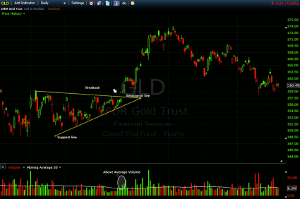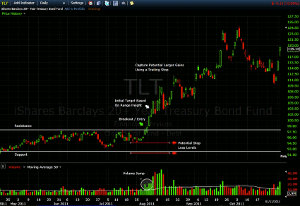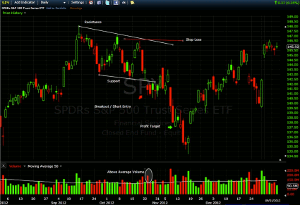Breakout strategies appeal to all traders and investors, from those trading one-minute charts to daily or weekly charts, notes Cory Mitchell of ETFdb.com, and VantagePointTrading.com.
ETFs, due to their ease of use, cost efficiency and liquidity, have become popular vehicles for breakout trading. With more than 1,400 ETFs on the market covering multiple asset classes and global markets, traders and investors can always find a breakout occurring or one close at hand. Once you learn how to spot potential breakouts, you’ll need a strategy to trade them.
Breakout Trading 101
A breakout occurs when an ETF moves above or below a support or resistance level. Support and resistance levels are horizontal or slanted lines that contain the ETF’s price action. If the breakout is to the upside, it signifies the bulls have won the battle, and the ETF is likely to proceed to higher. If the breakout is down, it signals the bears have won and the ETF is likely to head lower.
Breakouts are highly tradable because the ETF must be in some sort of consolidation period—moving between support and resistance—before a breakout can occur. When the price is contained for a period of time, it acts like a coiled spring, resulting in a sharp move once the bulls or bears break the price above resistance or below support. For this reason, volume should increase on a breakout, or at minimum should be above average.
Figure 1 shows the SPDR Gold Trust (GLD) stuck in a tightening pattern, called a triangle, throughout much of June, July, and August of 2012. Drawing lines along the price lows and price highs during this period highlights how the price was getting compressed, readying itself for a move. An upside breakout occurred in late August, resulting in an aggressive move higher.

Figure 1. SPDR Gold Trust – Breakout Daily Chart. Source: FreeStockCharts
Click to Enlarge
How to Trade Breakouts in ETFs
To find a potential breakout trade, look for ETFs that are bound by support or resistance levels. These levels are drawn by connecting more than two price highs for a resistance level and two price lows for a support level. Support and resistance may be horizontal, for example, when an ETF is moving up and down within a range between $9 and $10. Support and/or resistance may also be sloping, like trendlines, as they were in Figure 1.
Support and resistance should be well defined, and generally the longer the ETF has been trading between support and resistance, the more reliable the breakout will be. This is because many traders begin to trade based on the small moves between support and resistance, but when the breakout occurs, many of those traders will be trapped and forced to exit their positions at a loss. Other traders will be seeing a profit, realize they are right, and look to grab more shares.
Therefore, an increase in volume should accompany a breakout, showing strong interest from traders. If volume doesn’t increase, the breakout may still be valid and worth trading, but the lack of interest should make you wary.
NEXT PAGE: Bullish & Bearish Examples |pagebreak|
There are a number of general price areas to place a stop loss order when trading breakouts. The most common area is just outside the opposite side of the pattern (a range or triangle for example) from the breakout. If resistance is broken, enter long and place a stop just below pattern support. If support is broken, enter short, and place a stop just above pattern resistance.
If a breakout occurs and there is a strong support or resistance within the pattern, this can also be used. Using such a level reduces the amount of money risked on the trade, but it has a higher chance of getting prematurely stopped out on a price fluctuation.
A breakout usually has a profit target that can be calculated based on the size of the pattern. The height of the pattern, at its widest point, is added to the breakout price providing an approximate target the price will reach. For example, if an ETF is ranging between $8.50 and $10, when it breaks above $10, the expected target is near $11.50 ($10 minus $8.50, plus $10). If the breakout is to the downside, the expected target is $7.00. Once the target has been reached, a trailing stop can capture larger gains on the remaining position.
Bullish Breakout Trade
From May through July of 2012, the Barclays 20+ Year Treasury Bond Fund (TLT) fluctuated in a range between $97.90 and $92.50, a range of $5.40. On August 29, the ETF moved above $97.90, signaling a long entry and target of $103.30 ($5.40 plus $97.90). A stop loss could have been placed just below the low of the range at $92.50, or below recent support within the range near $94.75.
The target was hit quickly, within a matter of days. It is recommended some profit is taken off the table at the profit target, but a trailing stop can be used on the remainder of the position to capture further gains should a large move develop, as it did here.

Figure 2. Barclays 20+ Year Treasury Bond Fund – Bullish Range Breakout.
Click to Enlarge
Bearish Breakout Trade
From mid-September through late October of 2012, the SPDR S&P 500 ETF (SPY) moved within a slanted range, with a height of $5.16, as shown in Figure 3. On October 23, the ETF broke below the lower trendline, signaling a short entry and target of $137.14. With a slanted range such as this, the breakout price will change over time. Therefore, when the actual breakout occurs, note the breakout price and calculate the profit target based on it. In this case $5.16 was deducted from a breakout price of $142.30.
A stop loss could have been placed just above the upper trendline at $146.52.
The target was hit a few weeks a later. It is recommended some profit is taken off the table at the profit target, but a trailing stop can be used on the remainder of the position to capture further gains.

Figure 3. SPDR S&P 500 ETF – Bearish Breakout.
Click to Enlarge
The Bottom Line
To trade ETF breakouts, look for liquid ETFs that are moving between well-defined support and resistance levels. These levels, when drawn, may be horizontal or slanted. Enter when the price breaks above or below support/resistance. Ideally, volume should increase on a breakout. An initial profit target is calculated by adding (upside breakout) or subtracting (downside breakout) the height of the ETF pattern to the breakout price. Some profit should be taken at this level, but a trailing stop can also be used to capture potential further gains on the remaining position.
By Cory Mitchell, Contributor, ETFdb.com, and Founder, VantagePointTrading.com



















